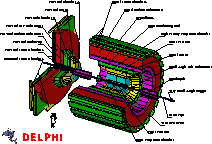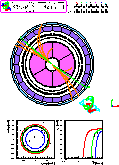LEP accelerates electrons and their anti-particles, positrons, in opposite directions in a vacuum pipe inside a retaining ring of magnets, before inducing them to collide head-on. In their annihilation, the energy released in a small volume is comparable to that which existed in the Universe a fraction of a second after its creation in the Big Bang, so there is a synthesis between the very large (cosmology) and the very small (particle physics).
LEP has four intersection regions, each surrounded by a particle detector to measure the properties of the secondary particles created from the electron-positron collision. Each of the detectors (DELPHI, ALEPH, L3 and OPAL) has been optimised differently to study various physics aspects.

DELPHI
is
an advanced detector. As well as having high precision and 'granularity',
it has the specific ability, using the Ring Imaging Cherenkov technique,
to differentiate between all the various secondary charged particles. It
also has an advanced silicon detector providing very precise tracking,
principally in order to detect very short lived particles by extrapolating
the tracks back towards the interaction point. Design and construction
of the DELPHI detector took 7 years; data have been taken every year for
the last 11 years.
The present collaboration consists of about 550 physicists from 56 participating universities and institutes in 22 countries.
The LEP collider's initial energy was chosen to be around 91 GeV, so that in these collisions a Z0 particle would be produced. The Z0 and its charged partner the W+-, both discovered at CERN in 1983, are responsible for the so-called "weak" force which drives our Sun. The theory of fundamental particles called the "Standard Model" has been critically tested by studying the creation and decay of the Z0. The Z0 is very short-lived, so its presence has to be inferred from its disintegration fragments, which may vary from two to nearly a hundred.
Since the end of 1995, LEP has moved on from the Z0 and entered its second phase. Its energy is being doubled to allow
 |
 |
| The DELPHI Detector | Nice pictures to download |
Back to DELPHI Home Page